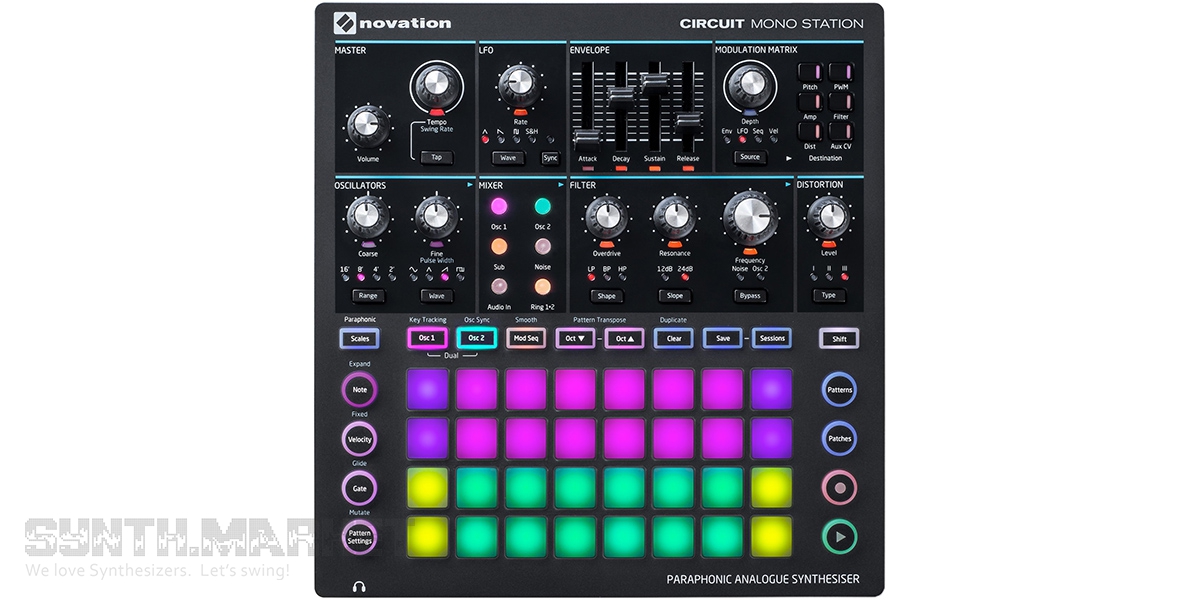The Novation Circuit Mono Station represents an innovative fusion of the original Circuit's acclaimed sequencing capabilities with the sonic prowess of the Bass Station II analog monosynth. This unique instrument combines a pad-grid controller, dual-oscillator sequencer, and comprehensive analog synthesis in a compact, performance-oriented package designed for both standalone use and modular integration.
The Circuit Mono Station builds upon the foundation of the original Circuit's intuitive 16-step sequencing system while introducing paraphonic capabilities through its dual-oscillator architecture. Unlike traditional monophonic synthesizers, the Mono Station can sequence both oscillators independently, creating harmonic textures, chords, and complex timbral variations that bridge the gap between monophonic and polyphonic synthesis.
The instrument features the complete Bass Station II sound engine with carefully considered enhancements, including a new distortion mode, expanded mixer section, and comprehensive modulation capabilities. The addition of CV, Gate, and Clock connectivity makes it an ideal centerpiece for hybrid setups, capable of interfacing seamlessly with modular synthesizers and other analog equipment.
The Circuit Mono Station's workflow centers around pattern-based composition, with 16 patterns available for the primary oscillator sequencer and 8 patterns each for the secondary oscillator and modulation sequencers. The instrument supports real-time and step sequencing, with extensive pattern manipulation features including variable length, speed, direction, and the new Mutate function for semi-random pattern variations.
Technical Specifications
Audio Architecture
- Synthesis Type: Analog monosynth with paraphonic capabilities
- Voice Architecture: Single voice path through VCA and filter
- Output: Single 1/4" TRS jack (mono, balanced/unbalanced compatible)
- Audio Input: 1/4" jack for external audio processing
- Headphone Output: 3.5mm jack (noted noise issues in review unit)
Oscillators & Sound Sources
- Primary Oscillators: Dual multi-mode oscillators
- Waveforms: Sine, Triangle, Sawtooth, Variable-width Pulse
- Sub Oscillator: Fixed-mode sub tracking Oscillator 1
- Noise Generator: Dedicated noise source
- Ring Modulation: Independent source between oscillators
- Oscillator Sync: Available for extended sound palette
Filter & Distortion
- Filter Type: Bass Station II 'Classic' mode design
- Filter Drive: Overdrive control for instant saturation
- Distortion: Two selectable types (can be used individually or combined)
- Filter Modes: Multi-mode capability
Modulation System
- Envelope Generators: 1 (reduced from Bass Station II's 2)
- LFOs: 1 (reduced from Bass Station II's 2)
- Modulation Matrix: Button-based matrix with single bipolar depth control
- Modulation Sequencer: 8 patterns × 16 steps with optional smoothing
- Per-Step Automation: All parameters can be automated per step
- Real-Time Automation: All parameters recordable in real-time
Sequencing Capabilities
- Sequencer Tracks: 2 independent note/gate sequencers
- Pattern Length: 16 steps (variable length supported)
- Pattern Storage:
- Oscillator 1: 16 patterns
- Oscillator 2: 8 patterns
- Modulation Sequencer: 8 patterns
- Pattern Features: Variable speed, direction (forward/backward/ping-pong/random)
- Pattern Chaining: Loop ranges by selecting two pads
- Mutate Function: Semi-random pattern alteration
- Real-Time Recording: Velocity capture (not available in step mode)
- Note Range: Two octaves within project scale
- Gate Length: Dedicated view for adjustment
- Velocity: Dedicated view for adjustment
Paraphonic Modes
- Mode 1: Only Osc 1 sequence triggers VCA/envelope
- Mode 2: Both sequences act as gates
- Dual Mode View: Play both oscillators simultaneously from pads
- MIDI Control: Separate MIDI channels (1 & 2) for each oscillator
Connectivity
- MIDI: USB-B port, 3.5mm MIDI I/O
- CV Outputs: 3.5mm CV out (tracks Osc 1 pitch with modulation)
- Gate Outputs: 3.5mm Gate out (from Osc 1, also Osc 2 in Paraphonic Mode 2)
- Clock: 3.5mm analog clock I/O
- Auxiliary CV: Modulation matrix destination for external modulation
- Voltage Standard: Volt-per-octave (0V = C1)
MIDI Implementation
- Channels: User-definable separate channels for both sequences
- Clock: Generate/chase MIDI Clock and analog clock
- Control Change: All panel controls transmit/receive MIDI CC
- CC Transmission: Can be disabled if required
- External Recording: Can record sequences from external MIDI sources
Memory & Project Management
- Sessions: Multiple sessions per project (smooth recall during playback)
- Session Switching: Quantized to bar (instant with Shift button)
- Patch Memory: Integrated with project recall
- Banks: 32 Sessions, 64 Patches (via Components software)
- Project Storage: Sequences and synth settings stored together
User Interface
- Controller: 4×4 pad grid with multiple views/modes
- LED Feedback: Brightness indicates parameter values on all controls
- Control Modes: Instant or pickup modes for parameter changes
- Color Coding: LED and pad backlighting for different functions
- Mixer: 6 dedicated mini pots with progressive LED level indication
Software Integration
- Components Software: Web interface or standalone app
- Cloud Backup: Project and patch storage
- Firmware Updates: Delivered through Components
- Session Management: Color-coding and visual grouping
- Current Version: v1.1+ (continuous updates)
Pattern Management Features
- Pattern Launch: Individual or chained loop ranges
- Pattern Length: Variable per pattern
- Pattern Speed: Adjustable per pattern
- Pattern Direction: Forward, backward, ping-pong, random
- Instant Switching: No quantization delays
- Pattern Interaction: All three sequences interact within synth engine
Scale System
- Scale Integration: Works within project's defined scale
- Note Selection: Scale-aware note entry and playback
Physical Dimensions & Power
- Panel Size: 240 x 250mm (9.4" x 9.8")
- Depth: 5cm larger front-to-back than original Circuit
Power
- 12V DC adapter (required, no battery or USB power option)












